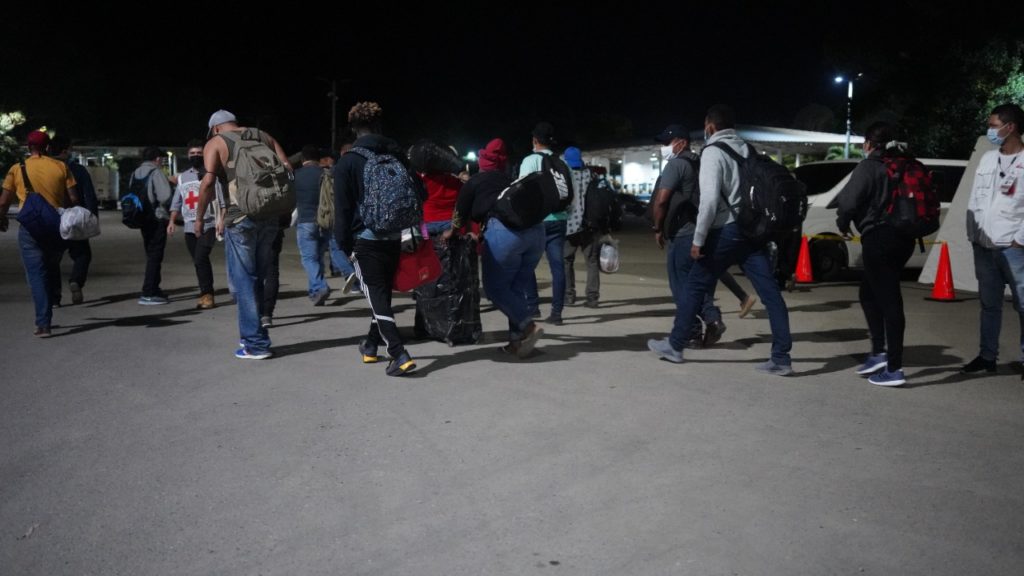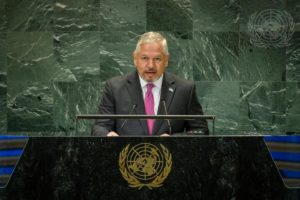Early on October 14, eleven buses carrying migrants arrived at the Guatemala-Honduras border. They had been deported by plane from the United States to Mexico, and then put on buses for the long journey home. No one from the Honduran government was there to record their arrival. According to non-governmental organizations that help deportees at the border, between 250 and 450 deportees have been arriving every night since mid-September.
By Allan Bu
Photos by Radio Progreso
It’s midnight at the Corinto border post between Guatemala and Honduras. There’s a warm breeze and traditional Mexican music is blaring from a nearby store. On this early morning in October and many times before, this border crossing, the springboard for many migrant dreams, now symbolizes the last nail in the coffin for the hopes of hundreds of Hondurans returning from the United States.
The deportation takes place at night ─ invisible, not registered, and with no Honduran officials in attendance. The massive repatriation of vulnerable migrants began a little over a month ago, according to a coalition of non-governmental organizations that provide assistance to returnees. They say that between 250 and 450 deportees are arriving every night.
“In fiscal year 2021, which began in October 2020, a total of 845,207 individuals have been detained, according to the Department of Homeland Security (DHS). This number will continue to rise.”
Early on October 14, eleven buses carrying migrants arrived at the Honduran border. Fernando, a 24-year-old man from the department of Olancho, was riding one of those buses. Just a few weeks earlier, he left home for the United States with his family, and traveled almost 2,200 kilometers from Corinto to Reynosa, Mexico, where they crossed into the United States.
Fernando said that their trip to the U.S. went very quickly even though he was traveling with his wife and their two young daughters. Their problems began once they thought they had accomplished their goal. After crossing the river, they turned themselves in to U.S. immigration officials, “We couldn’t evade the checkpoints because that’s a three-day walk and I was carrying the little girls.” They also thought that they wouldn’t be deported if they entered the U.S. with minors. “People we met on the way said that the U.S. wasn’t deporting anyone,” said Fernando.
In 2014, a large number of migrants arrived at the U.S.-Mexico border. More than 46,000 unaccompanied children and youths were detained. The BBC Mundo news outlet reported back then that the surge in migration was due to rumors in Central America that unaccompanied minors and women traveling with children were not being deported from the United States. This same misinformation is still circulating, which is why many people like Fernando are turning themselves in to immigration officials when they cross the border into the United States.
In an interview with Contracorriente, Amelia Frank Vitale, an expert in Central American migration, said that the Biden administration will seek a path to legal and permanent status for undocumented immigrants and those with temporary protected status (TPS) in the U.S., but that this doesn’t imply opening up the country to new migrants.
For Fernando and his family, the American dream ended just as it was getting started. He tells us how his family and 150 other people were forced to walk for two hours from the U.S.-Mexico border to the city of McAllen, Texas, where they boarded buses that took them to the infamous “coolers,” as the migrants call the detention centers because they are typically over-cooled. They stayed there for four days.
Read (in Spanish): Development aid: one of the main causes of migration by minors
Fernando says that during their stay in the “coolers,” they were made to bathe at two in the morning, causing his daughters to get sick with respiratory problems. For food, they were given flour tortillas and lettuce. As they were being processed into the detention center, they were asked for the contact information and addresses of the people waiting for them in the United States, “Supposedly they were going to contact them to come and pick us up, but nothing happened after that. They kept us in the cooler for four days without telling us anything.”
On October 13, Fernando and his family were ushered into a room at the detention center with some other people. When his family was called up, Fernando thought that he was going to reunite with them. But when they were taken by bus to the McAllen airport and put on a plane, Fernando knew something was wrong. When people asked immigration officials what was going on, they replied that they didn’t know anything. “Then, when I least expected it, the plane landed and we saw a Welcome to Villahermosa sign at the airport.”
The migrants on the plane demanded to know why they were being sent to Villahermosa in the Mexican state of Tabasco if they weren’t Mexican citizens. Then, Mexican immigration officials put them on a bus to Corinto, on the Guatemala-Honduras border.
“They didn’t give us anything but bread and water,” said Fernando, rubbing his stomach. “They tricked us. Supposedly we were going to be reunited with family [in the U.S.] ─ they even called our families. They were surprised to hear that I was back in Honduras. I was able to call when our phones were returned.”
Receiving the migrants
The border was closed when Fernando and 400 others arrived; the Honduran government has no record of this deportation. The repatriated Hondurans are assisted instead by non-governmental organizations (NGOs) such as UNICEF, Doctors Without Borders, the National Foundation for the Development of Honduras (Fundación Nacional para el Desarrollo de Honduras – FUNADEH), the International Organization for Migration (IOM), the Red Cross, and the United Nations High Commissioner for Refugees (UNHCR).
These NGOs provide the repatriated Hondurans with some basic necessities and food, like hot coffee, instant soup, and bread with ham and cheese. They can also make phone calls, charge their cell phones, and access the Internet. The NGOs have a bus to take returning migrants from Corinto to the San Pedro Sula main bus terminal, but can’t help all the travelers.
If someone needs psychological or emotional counseling, Doctors without Borders and FUNADEH have counselors who can help people cope with the frustration and despair that comes with deportation. One of the volunteers who wished to remain anonymous told us, “They feel hopeless and discouraged. The coyotes sell an idea ─ ‘I’ll take you there and when you turn yourself in, they’ll give you asylum.’ But that’s not what happens.”
The volunteer told us that she was surprised to see so many children among those that arrived in Corinto that morning in October. “It’s heartbreaking to see entire families,” she said. She remembers one four-year-old boy who said they hadn’t eaten for three days. “And it was all for nothing,” he added innocently.
The coalition of NGOs has been attending to the migrants at the border for three weeks now, but these repatriations have been going on for much longer, “We started to help three weeks ago because we heard that no one was there at the border to receive them. People in the community were telling us that the migrants were arriving at night.”
Karla Rivas, regional coordinator for the Jesuit Network for Migrants in Central America, told Contracorriente that Nicaraguan and Salvadoran deportees are also arriving at the Corinto border crossing, “but over 98% are Hondurans.”
Rivas says that 8,000 deportees from the United States have arrived in the past four weeks, and that Honduran immigration officials have not recorded this influx of repatriated citizens. But Rivas doesn’t think that that’s the main problem. “The issue is not that nobody is there to record their arrival, it’s that nobody is there to help them.”
They also turned themselves in
We met Javier Vargas and Dinora Perez, a couple from Tegucigalpa, in the dark of night on the Guatemalan side of the border. They traveled north with their four-year-old daughter a month ago on a series of trains, minibuses, and buses. When they crossed the Rio Grande, they turned themselves in to U.S. immigration officials. Vargas says they did this because they heard that the U.S. was granting asylum.
“But apparently they’re not granting anything. I had heard that people with children were getting in ─ that’s why we turned ourselves in,” he said.
Once detained, it’s the same story. They were asked for some basic information and if they had relatives in the United States. Then they were kept for four or five days in the “cooler.” After that they are flown to Villahermosa and put on buses to Corinto. Dinora Perez told us that many Guatemalans and Hondurans were also turning themselves in when they were there. The coyotes instruct them to turn themselves in because they can get asylum. But in detention, they weren’t given any information and were not allowed to make phone calls.
Javier and Dinora wanted to leave the country so their daughter could have better opportunities in life. They don’t view Honduras as a place where she can grow up and have a decent life. But now they are giving up on the idea of migrating.
“Supposedly they provide [asylum]. You try to give your children better opportunities. I’m 48 years old; nobody wants to give me work anymore, so what can I offer my daughter?” asks Dinora, as she leans against the wall of a convenience store on the Guatemalan side of the border.
Fernando is giving up after this latest experience ─ he has tried four times to migrate. “It’s not easy,” he says. However, the flow of migrants to the United States continues. Karla Rivas says that data from the Catholic Church’s Human Mobility Pastoral indicates that 600 people leave Honduras every day to pursue the American dream.








